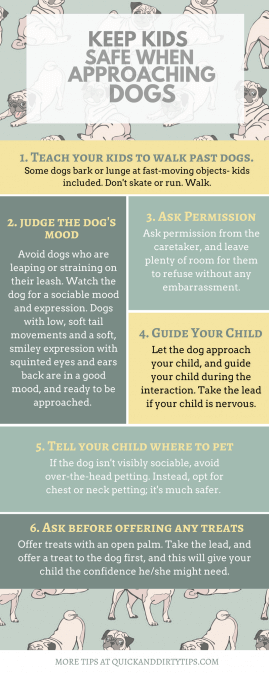How to Keep Kids Safe Around Dogs
Kids often want to say hi to dogs on the street, and vice versa. When is it safe?
 Susan writes about her neighbor’s Great Dane, who eagerly greets Susan’s 6-year-old daughter, Laura. One day recently, Laura darted a hand over the dog’s head–something Susan had always told her not to do. The dog growled, lunged, and took Laura’s arm gently in his mouth. Susan’s spooked and doesn’t know what to do.
Susan writes about her neighbor’s Great Dane, who eagerly greets Susan’s 6-year-old daughter, Laura. One day recently, Laura darted a hand over the dog’s head–something Susan had always told her not to do. The dog growled, lunged, and took Laura’s arm gently in his mouth. Susan’s spooked and doesn’t know what to do.Actually, she does, because I replied to her email as soon as I could wipe the cold sweat off my palms. This week, how to keep kids safe around dogs–how to tell when a situation’s safe, and when it isn’t.
How to Keep Kids Safe Around Dogs
Let’s start with you, the parent out walking with your animal-loving kid. He wants to say hi to every dog he sees. I don’t need to tell you never to let your child run at a strange dog, right? Small, cute dogs get a lot of this very understandable kid behavior, and it often scares the heck out of them. While we’re on the subject, teach your child to walk past dogs. Don’t run, don’t skateboard, don’t do handsprings. Some dogs bark and lunge at fast-moving objects, kids included. Walking past dogs is safer for your child.
How to Tell if a Dog Is Child Friendly
You may want to rule out dogs who are leaping and straining on the leash–they may well be friendly, but I’d peg them as Likeliest to Jump and unintentionally scare a kid. Most important of all, you need to spot dogs likely to enjoy the meeting and not respond with a growl, a snap, or worse to any mistake a child may make.
Ask Permission Before Saying Hi
Ask the caretaker’s permission first–leaving plenty of room to refuse. “May my daughter say hello to your dog?” can be answered with “I’m sorry, not right now” without embarrassing the guardian of a difficult dog. It also leaves a courteous out for someone in a hurry.
Avoid questions such as “Does your dog like children?” Many people don’t read their dog’s signals well enough to know. Also, people with difficult dogs are often shamed and blamed. So they make excuses for their dogs, or never quite manage to remember that their beloved Dogalini snaps at children who bend over her. After all, only a bad dog would snap at a child.
Guide Your Child During the Greeting
Assuming the dog’s handler says, “Why yes, of course,” you’ll still need to guide your child’s behavior and also watch the dog. I think for many people, it feels as though you’re more in control if the child approaches the dog. But it’s better to let the dog approach. It buys you a bigger margin of safety in case you’ve misread the dog’s signals and he’s uneasy, or in case you haven’t seen any problematic signals because the dog doesn’t respond with a threat unless he’s approached.
I realize this also sounds as if you have to ask your child for a ton of impulse control. But a dog who’s comfortable with children and enjoys meeting them won’t make her wait for long, I promise! As the dog approaches, watch for low, soft tail movements, maybe with some butt wiggles thrown in. A soft, smiley expression with squinty eyes and with ears back marks a sociable, relaxed mood. Sniff sniff, sniff, and now let’s turn to the question of petting.
Show Your Child How Dogs Like to Be Petted
Dogs shouldn’t have to accept rough treatment, and bad experiences may make them less friendly to other children in future. Help your child interact in ways both she and the dog enjoy.
Susan, whose daughter Laura had that scary experience with the Great Dane, gave excellent guidance when she told Laura not to bring her hand above the dog’s head.
A dog who’s given the relaxed, friendly greeting I just described isn’t likely to bite because a kid pets the top of his head, but most dogs don’t enjoy over-the-head maneuvers. You’ll see them duck away, or stand there sucking it up but not liking it. Chest scratches and side-of-neck scratches generally go over well. Same goes for scritching the spot just above a dog’s tail. Many dogs like ear rubs, but floppy, hairy ears run to infections that can hurt like the dickens when the ears are touched. So with an unknown, floppy-eared dog, I usually steer clear of ear rubs. Go for Zippy’s cheeks and that spot just behind his chin instead.
How to Give Treats
Ask before giving a treat. Many dogs have food sensitivities. To give a treat, have your child open her hand flat. Lay the treat in the flat of the hand and guide your child to keep her hand flat as the dog takes the treat. Many perfectly nice dogs will snatch food from between fingers, so keeping a flat hand will save a lot of ouchies.
I’d also suggest that if your child is at all nervous, you give a treat first, or skip it altogether. Nervous kids often bring their hands forward and then snatch them back–a good way to get dogs to dart in and grab the food. Which scares the child and leaves him more nervous the next time he meets a dog. Counterproductive.
So many children love dogs, but get little guidance on how to engage with them safely and pleasantly. Dogs are a mixed bag. Some are relaxed and sociable, others skittish and touchy. (I told Susan that Laura should steer clear of the arm-grabbing Great Dane from now on.) You don’t have to guess which is which, and you don’t have to choose between letting your child enjoy contact with dogs and keeping her or him safe. Here in Brooklyn, it’s finally spring, and kids and parents are out enjoying the sun. Yes, you’re welcome to say hi to my doggy.
Until we run into each other in person, send questions and comments to dogtrainer@quickanddirtytips.com. I Twitter as Dogalini, and you can also find The Dog Trainer on Facebook, where I post links to articles and videos and respond to your questions. Thanks for reading!
Resources
Some good websites present and explain photos of dog behavior. See https://www.squidoo.com/readyerdog and https://www.wagntrain.com/BodyLanguage.htm for two I really like


